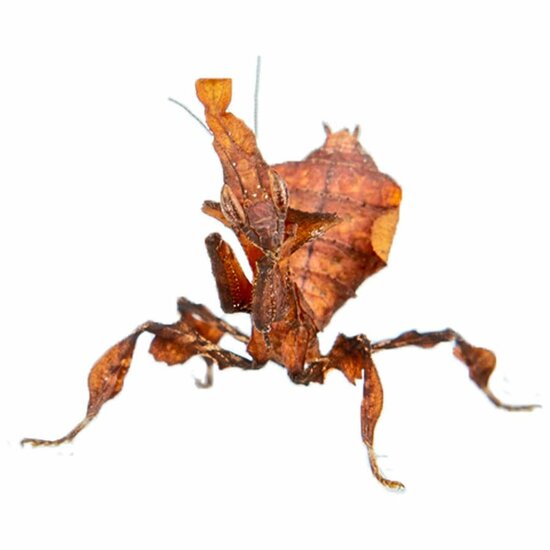
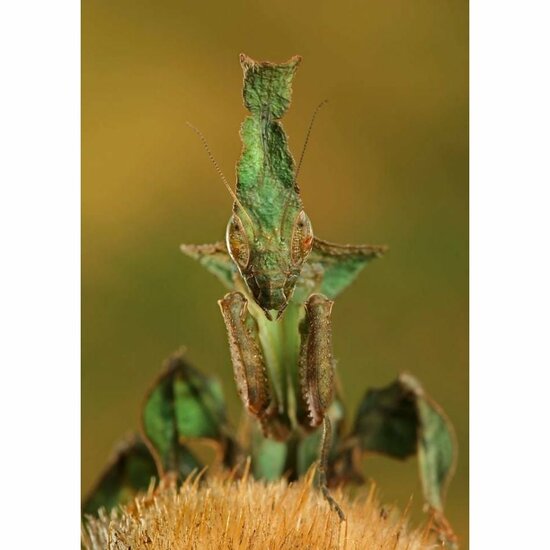
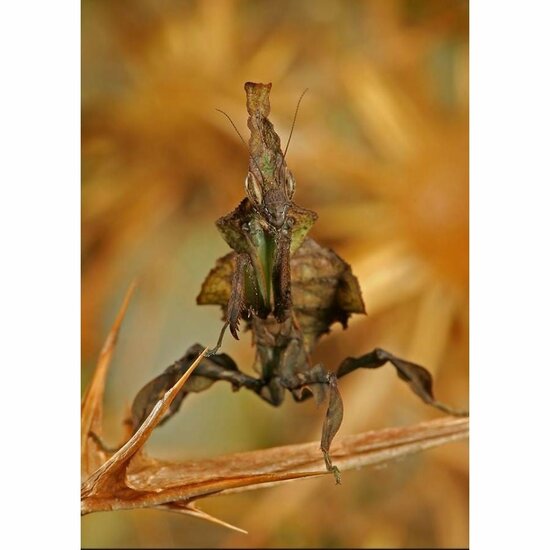
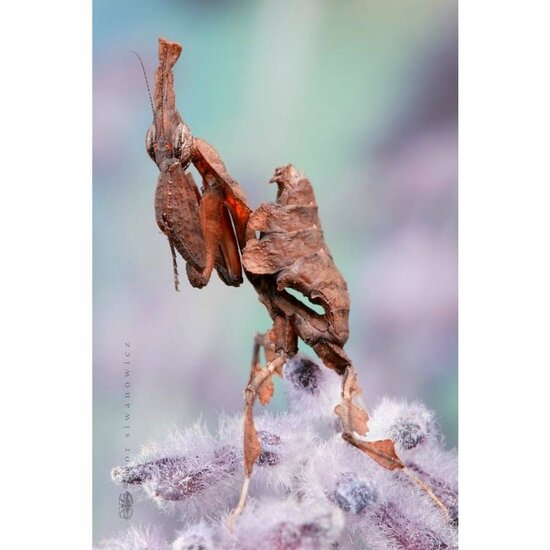
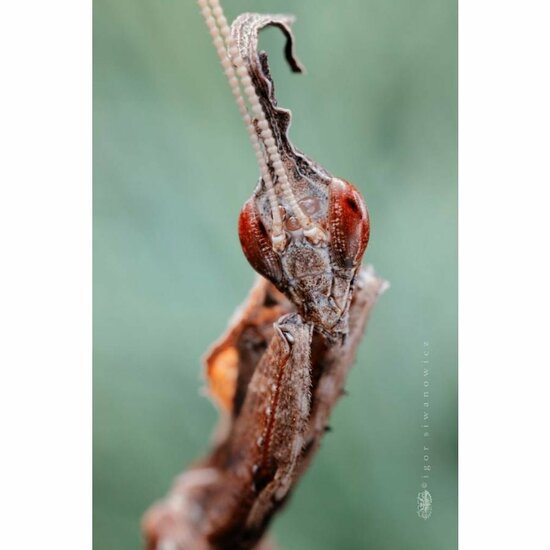
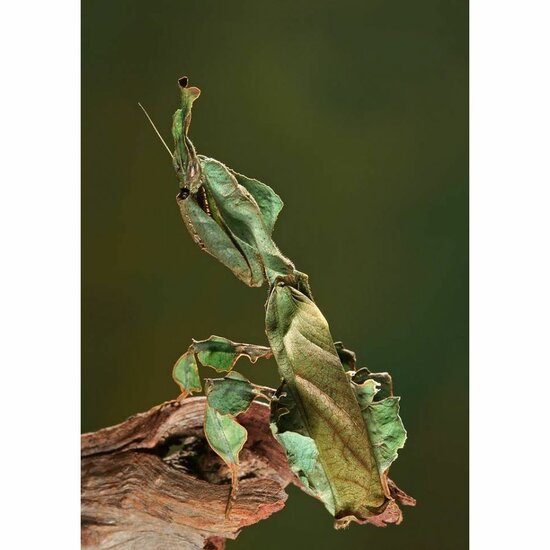
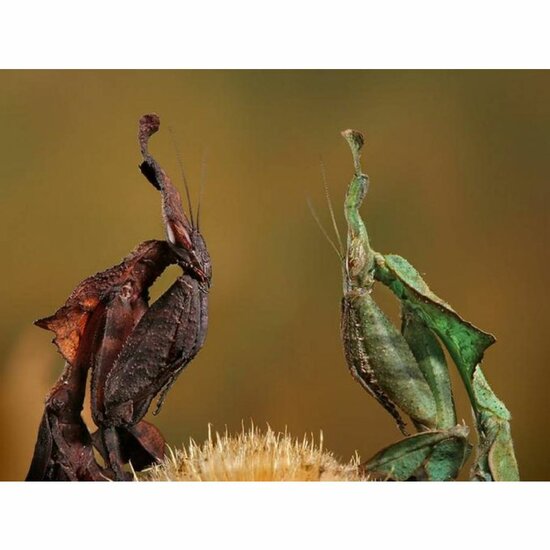







- Ants as pets since 2009 It starts here!
- We ship every working day until 4:30 PM
- Flat shipping costs from €6.99
- Specialists in ants, free advice
Do you have questions about this product?
Or do you need help? Please feel free to contact us, we are happy to help!
Product description
Paradoxa Praying Mantis
The nymph stage is between L3 and L7.
Information
Phyllocrania paradoxa is also called Ghost Mantis in English. She owes this name to her special shapes and alien-like head. The species can be recognized by a long asymmetrical shaped protuberance on the head, which serves to look more like a withered leaf. Phyllocrania paradoxa occurs naturally in Madagascar and Africa.
Appearance
This species of praying mantis mimics dry leaves so that it does not stand out among fallen leaves in the forest areas where it occurs. This way it can unexpectedly grab prey and still remain unseen by predators such as insect-eating birds. The most common color in this species is dark brown, but sometimes a green specimen can also be found. This color is determined by the environment; a moister, greener environment more often produces a green animal. P. paradoxa grows to about 5 cm in length, with little difference in size between the sexes. The males are narrower with slightly longer wings than the abdomen. The females are broader with a broader prothorax and with wings that extend to the abdomen.
Behaviour
Phyllocrania paradoxa is a quiet species of praying mantis. It is a typical sit-and-wait predator. Relying on her camouflage, she waits patiently for unsuspecting prey to pass by. As soon as she spots it, she strikes with lightning speed, and before the prey knows it, it is already firmly stuck between the catching arms of this predator. P. paradoxa will rarely actively pursue prey itself, but rather wait for an opportune moment to strike. Sometimes this kind of praying mantis is also a bit cautious and a bit afraid. Large tweezers or a large hand in the cage will cause prey to be rejected. Just wait fifteen minutes and try again, then everything will be fine again.
Food
In nature, Phyllocrania paradoxa mainly eat flying insects. So it would be good to offer them flies instead of crickets. However, crickets are also well eaten and are therefore excellent food for these animals. Just make sure that there are no stray crickets hanging around in the cage when the praying mantis is molting. An adult P. paradoxa can handle adult crickets, but it is better to give them smaller crickets, e.g. size 6 or 7. P. paradoxa are a bit intimidated by large tweezers with prey.
Environmental requirements
The ideal temperature is about 26°C, but can vary between 20°C and 30°C. At night it may be slightly cooler than during the day, but at least 18°C. This species needs relatively high humidity. About 60 to 90% humidity. This is achieved by spraying with water approximately 5 times a week. As with all praying mantis species, this species requires an enclosure that is at least 3x the animal's length high, and at least 2x the animal's length wide. For an adult animal this means at least 15 cm in height and 10 cm in width. A nice size for a terrarium would be 20 x 20 x 30, so that there is also room for fake plants and plenty of perches. Dry leaves color beautifully in this species, sometimes they completely blend in with the environment.
Group housing
The special thing about this species of praying mantis is that they can often be kept together their entire lives without cannibalism. The conditions for this are that the animals always have enough to eat and that the enclosure is sufficiently large. Many people successfully keep groups of P. paradoxa in a large terrarium. The chance of cannibalism is small, but it always remains with these types of predators.
Paradoxa Praying Mantis
The nymph stage is between L3 and L7.
Information
Phyllocrania paradoxa is also called Ghost Mantis in English. She owes this name to her special shapes and alien-like head. The species can be recognized by a long asymmetrical shaped protuberance on the head, which serves to look more like a withered leaf. Phyllocrania paradoxa occurs naturally in Madagascar and Africa.
Appearance
This species of praying mantis mimics dry leaves so that it does not stand out among fallen leaves in the forest areas where it occurs. This way it can unexpectedly grab prey and still remain unseen by predators such as insect-eating birds. The most common color in this species is dark brown, but sometimes a green specimen can also be found. This color is determined by the environment; a moister, greener environment more often produces a green animal. P. paradoxa grows to about 5 cm in length, with little difference in size between the sexes. The males are narrower with slightly longer wings than the abdomen. The females are broader with a broader prothorax and with wings that extend to the abdomen.
Behaviour
Phyllocrania paradoxa is a quiet species of praying mantis. It is a typical sit-and-wait predator. Relying on her camouflage, she waits patiently for unsuspecting prey to pass by. As soon as she spots it, she strikes with lightning speed, and before the prey knows it, it is already firmly stuck between the catching arms of this predator. P. paradoxa will rarely actively pursue prey itself, but rather wait for an opportune moment to strike. Sometimes this kind of praying mantis is also a bit cautious and a bit afraid. Large tweezers or a large hand in the cage will cause prey to be rejected. Just wait fifteen minutes and try again, then everything will be fine again.
Food
In nature, Phyllocrania paradoxa mainly eat flying insects. So it would be good to offer them flies instead of crickets. However, crickets are also well eaten and are therefore excellent food for these animals. Just make sure that there are no stray crickets hanging around in the cage when the praying mantis is molting. An adult P. paradoxa can handle adult crickets, but it is better to give them smaller crickets, e.g. size 6 or 7. P. paradoxa are a bit intimidated by large tweezers with prey.
Environmental requirements
The ideal temperature is about 26°C, but can vary between 20°C and 30°C. At night it may be slightly cooler than during the day, but at least 18°C. This species needs relatively high humidity. About 60 to 90% humidity. This is achieved by spraying with water approximately 5 times a week. As with all praying mantis species, this species requires an enclosure that is at least 3x the animal's length high, and at least 2x the animal's length wide. For an adult animal this means at least 15 cm in height and 10 cm in width. A nice size for a terrarium would be 20 x 20 x 30, so that there is also room for fake plants and plenty of perches. Dry leaves color beautifully in this species, sometimes they completely blend in with the environment.
Group housing
The special thing about this species of praying mantis is that they can often be kept together their entire lives without cannibalism. The conditions for this are that the animals always have enough to eat and that the enclosure is sufficiently large. Many people successfully keep groups of P. paradoxa in a large terrarium. The chance of cannibalism is small, but it always remains with these types of predators.
Reviews
No reviews yet
More information...
If you have any questions, please don't hesitate to contact us, we like it! You can reach us via email and WhatsApp. You are welcome in the showroom by appointment for advice and purchase!
Customer service Make an appointment
